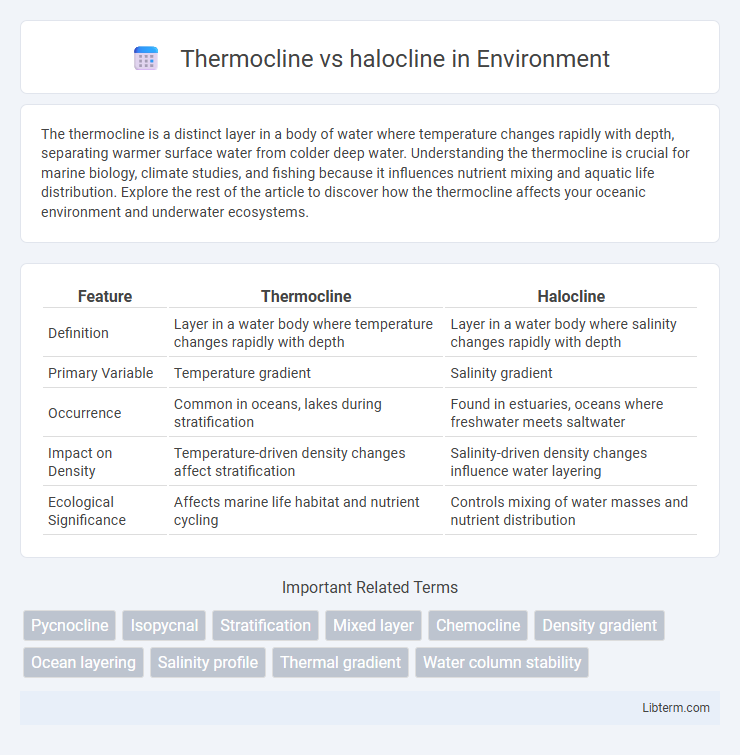The thermocline is a distinct layer in a body of water where temperature changes rapidly with depth, separating warmer surface water from colder deep water. Understanding the thermocline is crucial for marine biology, climate studies, and fishing because it influences nutrient mixing and aquatic life distribution. Explore the rest of the article to discover how the thermocline affects your oceanic environment and underwater ecosystems.
Table of Comparison
| Feature | Thermocline | Halocline |
|---|---|---|
| Definition | Layer in a water body where temperature changes rapidly with depth | Layer in a water body where salinity changes rapidly with depth |
| Primary Variable | Temperature gradient | Salinity gradient |
| Occurrence | Common in oceans, lakes during stratification | Found in estuaries, oceans where freshwater meets saltwater |
| Impact on Density | Temperature-driven density changes affect stratification | Salinity-driven density changes influence water layering |
| Ecological Significance | Affects marine life habitat and nutrient cycling | Controls mixing of water masses and nutrient distribution |
Introduction to Thermocline and Halocline
The thermocline is a distinct layer in a body of water where the temperature changes rapidly with depth, separating warmer surface water from colder deep water. The halocline is a similar stratification layer but characterized by a sharp salinity gradient, often found in estuaries or areas where freshwater meets seawater. Both thermoclines and haloclines significantly influence oceanic and aquatic ecosystems by affecting water density, circulation, and marine life distribution.
Defining Thermocline: Temperature Gradients in Water
Thermocline refers to a distinct layer in a body of water where temperature changes rapidly with depth, creating a temperature gradient between the warmer surface water and the colder deep water. This thermal stratification significantly influences aquatic ecosystems, affecting oxygen levels, nutrient distribution, and marine life habitats. Unlike halocline, which involves salinity gradients, thermocline specifically denotes temperature changes as a primary factor impacting water column structure.
Understanding Halocline: Salinity Layers in Aquatic Environments
Halocline refers to a distinct layer in aquatic environments where there is a sharp gradient in salinity, often found in estuaries, fjords, and oceans where freshwater mixes with seawater. This salinity stratification significantly affects water density, influencing marine circulation, nutrient distribution, and the habitat layering of aquatic organisms. Understanding haloclines is crucial for studying estuarine dynamics, biological productivity, and the impact of salinity fluctuations on marine ecosystems.
Formation Mechanisms: How Thermoclines and Haloclines Develop
Thermoclines develop due to rapid temperature changes with depth, where solar heating warms surface waters while deeper layers remain cold, creating a steep thermal gradient. Haloclines form through variations in salinity caused by freshwater input, evaporation, or ice formation, leading to distinct layers with different salt concentrations. Both processes create stratified water columns that impact ocean circulation and marine ecosystems.
Physical and Chemical Differences
Thermocline represents a temperature gradient in a water column where temperature rapidly decreases with depth, significantly impacting water density and marine life distribution. Halocline refers to a salt concentration gradient where salinity changes sharply with depth, influencing water's buoyancy and chemical composition. Unlike thermocline, which affects thermal energy and temperature-driven circulation, halocline primarily alters the chemical properties and osmotic balance in aquatic environments.
Ecological Significance of Thermoclines
Thermoclines create distinct temperature layers in aquatic ecosystems, influencing species distribution and nutrient cycling by restricting vertical mixing. These temperature gradients support diverse habitats by enabling stratification that separates oxygen-rich surface waters from colder, nutrient-dense deeper layers. The ecological role of thermoclines is critical for sustaining marine food webs, regulating primary productivity, and maintaining overall ecosystem stability.
Ecological Role of Haloclines
Haloclines create sharp salinity gradients in aquatic environments that influence the distribution and behavior of marine organisms, serving as barriers that limit vertical mixing and promote habitat stratification. These salinity layers enhance nutrient retention and cycling, supporting diverse microbial communities and influencing productivity patterns. The presence of haloclines often establishes unique ecological niches critical for species adapted to specific salinity ranges, impacting biodiversity and ecosystem stability.
Thermocline vs Halocline: Key Comparisons
Thermocline and halocline are crucial layers in oceanography, with thermocline characterized by a rapid temperature gradient and halocline by a sharp salinity change. The thermocline typically occurs between the mixed surface layer and the deeper ocean, influencing marine life and ocean circulation, whereas the halocline is most prominent in estuaries and polar regions, affecting density and stratification. Understanding the depth, cause, and impact of thermocline versus halocline helps in predicting ocean behavior and ecosystem dynamics.
Impacts on Marine Life and Oceanography
Thermoclines create distinct temperature layers that influence marine species distribution by limiting vertical movement and nutrient mixing, impacting primary productivity and biodiversity. In contrast, haloclines, defined by salinity gradients, affect water density and stratification, which can alter ocean circulation patterns and habitat suitability for osmoregulatory organisms. Both thermoclines and haloclines play crucial roles in shaping oceanographic processes such as nutrient cycling, oxygen availability, and marine ecosystem dynamics.
Conclusion: Importance in Oceanic and Freshwater Systems
Thermoclines and haloclines play crucial roles in regulating temperature and salinity gradients in oceanic and freshwater systems, directly influencing aquatic life distribution and nutrient cycling. Understanding these stratifications helps predict ecosystem responses to environmental changes and supports sustainable management practices. Their dynamic interactions affect ocean circulation patterns and freshwater stability, underlining their importance in maintaining aquatic biodiversity and water quality.
Thermocline Infographic

 libterm.com
libterm.com